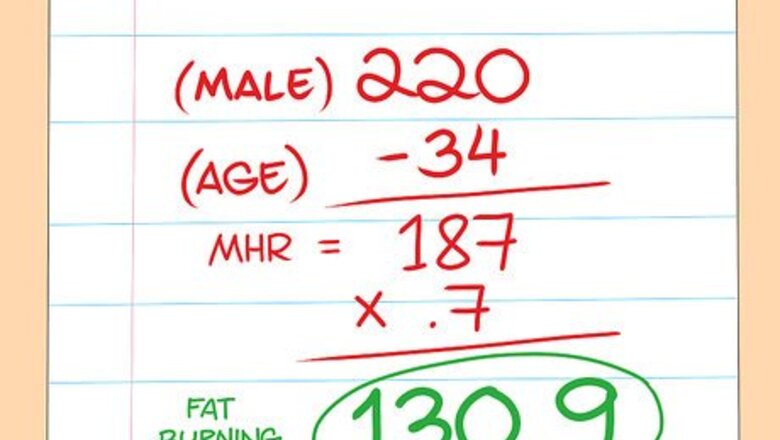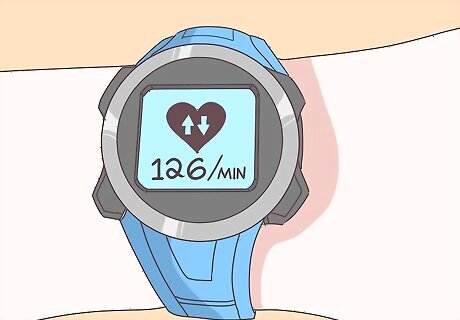
views
X
Research source
If weight loss is the goal of your workout, then finding your fat-burning zone and maintaining your workout in that zone may maximize the amount of fat you burn. The fat-burning zone is different for everybody, but can be helpful when you're working out to help you adjust the intensity of your workout based on your heart rate.
Determine Your Fat-Burning Zone

Calculate your fat-burning zone with a formula. There's a relatively simple formula to help you determine where your fat-burning zone falls. It's not 100% accurate, but will give you a relatively reliable range to aim for. First, find your maximum heart rate (MHR). To do this, subtract your age from 220 if you're male; subtract your age from 226 if you're female. Your fat-burning zone is between 60% and 70% of your MHR (Your MHR multiplied by .6 or .7). For example, a 40 year old man's MHR would be 180, and his fat-burning zone would be between 108 and 126 beats per minute.

Purchase or use a heart rate monitor. There are a variety of heart rate monitors available— watches or wristbands, chest straps, and even built into handle bars of some cardio machines. Heart rate monitors can help you accurately see where your heart rate is and based on your age, height, and weight can also determine your fat-burning zone. By using a heart rate monitor, you're going to get a more accurate idea of where your fat-burning zone is. This is because the heart rate monitor will calculate your heart rate as you exercise and will then use your actual heart rate information to calculate your fat-burning zone. Many people that use a heart rate monitor for the first time realize that they may not have been working out as hard as they thought. Pay close attention and challenge yourself- safely. Although many cardio machines—like a treadmill or elliptical—offer a built-in heart rate monitor, they are not always 100% accurate. Heart rate monitors that use a chest strap are slightly more accurate than wristbands or watches. They are generally also slightly more expensive.

Take a VO2 Max test. A VO2 max test (volume per time, oxygen, and maximum) test will accurately record your body's ability to transport and use oxygen during exercise. This test requires the participant to walk on a treadmill or use a bike and breathe into a face mask that measures oxygen and carbon dioxide levels as your heart rate increases. This information can then be used to determine at what heart rate level you are burning the most fat and calories in your fat-burning zone. The VO2 Max test is considered one of the most accurate and reliable testing methods for cardiovascular fitness. You can take a VO2 max test at a gym, some labs, and private doctors offices.

Use the talk test. This is the least technical of all the ways to determine your fat-burning zone. The talk test requires to you talk during exercise and based on how winded you are, you can determine if you need to increase or decrease the intensity of your workout. For example, if you are too winded to talk then you need to decrease the intensity of your workout. If you can talk easily, then you're not working out hard enough. You should be able to say one short sentence without a problem.
Applying Your Fat-Burning Zone to Exercise

Include a variety of cardio exercises. Choosing a combination of moderate- and high- intensity cardio exercises will typically yield the best results. This will be especially true if your goal is weight loss. Include activities that are moderate-intensity and fall into your fat-burning zone about half of the time. Activities may include: slower jogging, biking or swimming. However, this will be different for everyone. Also choose some cardio activities that fall into a high-intensity range. Although this falls out of your fat-burning zone, you burn more calories overall and increase your body's cardiovascular fitness levels. In general, you burn more calories at the zone above your fat-burning zone (the aerobic/cardio zone) which is generally at a higher intensity. However, total calories burned also depends on the duration of a workout and it may be easier to do a longer work out in the fat-burning zone as it's at a lower intensity. Also, aim to reach 150 minutes of moderate-intensity cardio activity each week at a minimum.

Include strength training exercises. Incorporating strength or resistance training into your weekly exercise schedule is important. It helps build and tone muscle in addition to increasing your metabolism. Weight training is critical for fat loss. It is crucial to keep and gain muscle while losing fat mass. Include strength training at least two days a week for a minimum of 20 minutes. Strength training activities include: weight lifting, isometric exercises (like push-ups or pull-ups) and Pilates.

Meet with a personal trainer or coach. If you're interested in your fat-burning zone and how you can best utilize that information, meeting with a personal trainer or coach may be a good option. They can help you find your fat-burning zone and help design an appropriate workout that utilizes that information. Talk to your trainer or coach about your goals. Is it weight loss? Increasing your muscle mass? This will help them tailor their program to meet your needs. Also ask how you can utilize your fat-burning zone to your best advantage.




















Comments
0 comment